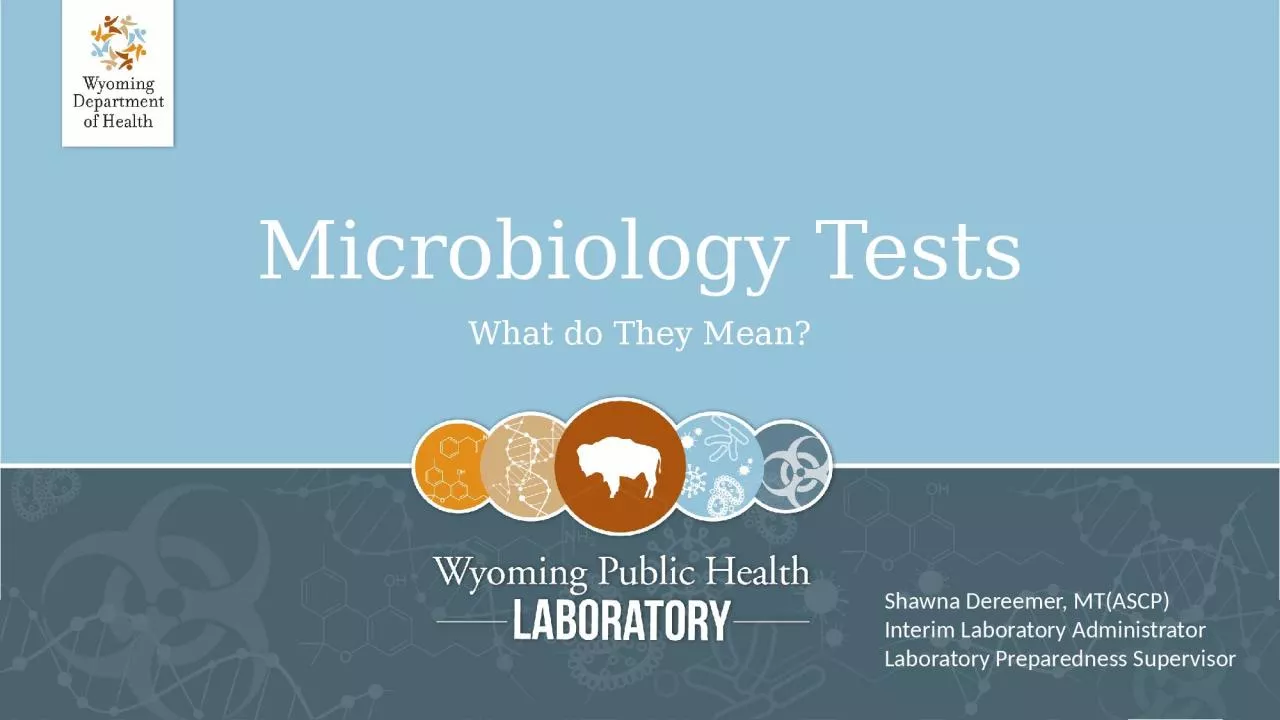

Shawna Dereemer MTASCP Interim Laboratory Administrator Laboratory Preparedness Supervisor Objectives Summarize various microbiology testing methods List components of a laboratory report Interpret various microbiological test results ID: 933544
Download Presentation The PPT/PDF document "Microbiology Tests What do They Mean?" is the property of its rightful owner. Permission is granted to download and print the materials on this web site for personal, non-commercial use only, and to display it on your personal computer provided you do not modify the materials and that you retain all copyright notices contained in the materials. By downloading content from our website, you accept the terms of this agreement.
Slide1
Microbiology Tests
What do They Mean?
Shawna Dereemer, MT(ASCP)
Interim Laboratory
Administrator
Laboratory Preparedness Supervisor
Slide2Objectives
Summarize various microbiology testing methods
List components of a laboratory report
Interpret various microbiological test results
Summarize antibiotic susceptibility testing and results
Slide3Wyoming Public Health Laboratory
Slide4Infectious Disease
BacterialViral
Parasitic
Slide5Supporting Laboratory Results
Viral
Identification
of virus
Normal or Decreased WBC Count
Increased Lymphocyte Count
Parasitic
Identification
of parasite
Increased Eosinophil Count
Bacterial
Identification of bacteria
Increased WBC Count
Increased Neutrophil Count
Left-shift in Neutrophil Cell Line
Increased CRP
Increased
Sed
-Rate
Slide6Laboratory Reports
Slide7Bacterial Culture
Grow and isolate bacteria
Various media
Identify a pathogen
Pros
Identify the isolate
Very specific
Cons
Lengthy
Normal flora
Slide8Biochemical Testing
Slide9Identification
Slide10Microbiology Standards
Slide11Antimicrobial Susceptibility Testing
Determine antibiotic susceptibility or resistance
P. aeruginosa
Ceftazidime 19mm Intermediate
Slide12Antimicrobial Susceptibility testing
Slide13Antimicrobial Susceptibility Testing
Slide14Antimicrobial Susceptibility Testing
P. aeruginosa
0.125 mg/dl Susceptible
Slide15Antimicrobial Susceptibility testing
Slide16Antimicrobial Susceptibility Testing
Slide17Molecular Testing
DNA Probes
DNA Sequencing
Nucleic Acid Sequencing (16s)
Whole Genome Sequencing (WGS or NGS)
Nucleic Acid Amplification Testing (NAAT)
Polymerase Chain Reaction (PCR)
Ligase Chain Reaction (LCR)
Transcription Mediated Amplification (TMA)
Slide18PCR
Slide19DNA Sequencing (16s)
Unusual isolatesAutomated instrumentation will not identify
Low confidence levels
Slide20Whole Genome Sequencing
Slide21Nucleic Acid Amplification Testing (NAAT)
Chlamydia/Gonorrhea testing
M. tuberculosis testing
Slide22Virology
PCRNo culture isolation
Slide23Parasitology
Slide24Immunology/Serology
Chlamydia/GC testingHIV
Hepatitis B & C
Slide25Immunology/Serology
Quantaferon (IGRA)
MMR status (measles, mumps and rubella)
Varicella (chicken pox)
Syphilis (RPR)
Slide26Water Lab
EPA Water Lab Total Coliform
E.coli
New environmental testing coming soon
Slide27Questions
Slide28Contact Information
Shawna Dereemer, MT(ASCP)
Interim Laboratory Administrator
Laboratory Preparedness Supervisor
s
hawna.Dereemer@wyo.gov
307-777-3735
Slide29References
M100 Performance Standards for Antimicrobial Susceptibility Testing, Clinical and Laboratory Standards Institute, 28
th
Edition, January 2018.